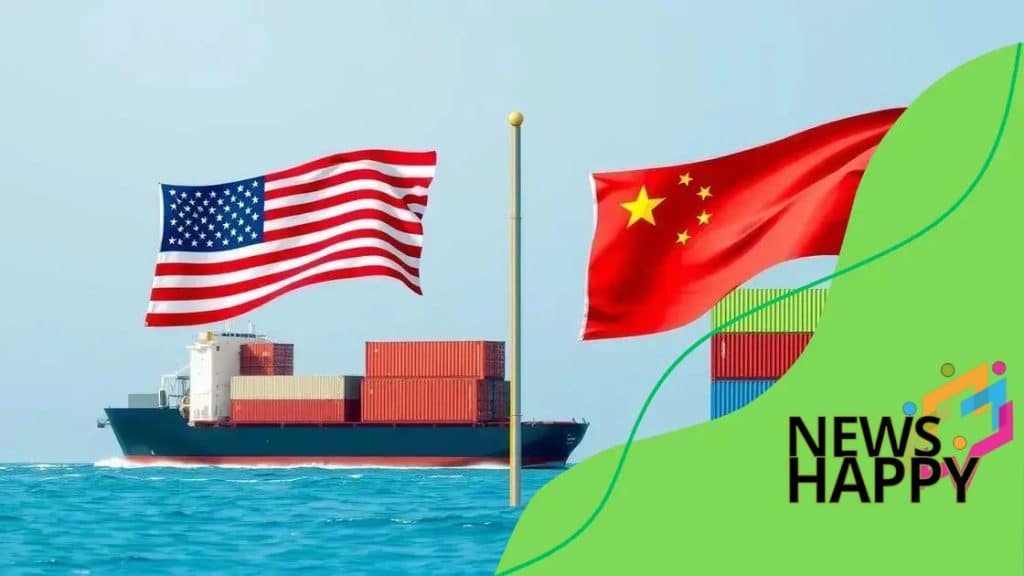US-China tariff reprieve: what it means for businesses

Anúncios
The US-China tariff reprieve offers businesses significant cost savings. This temporary suspension of tariffs can reduce import costs, benefiting both companies and consumers.
As tariffs are reduced, businesses can adjust pricing strategies. The tariff reprieve allows for smoother operations and more stable pricing in many sectors.
With these savings, companies can increase profitability. They can also pass on the benefits to consumers, stimulating market growth and improving demand.
Anúncios
Understanding the US-China tariff reprieve
The tariff reprieve temporarily suspends certain tariffs on Chinese goods. This change marks a crucial shift in US-China trade relations with long-term implications.
For businesses, the reprieve means lower import costs. It offers an opportunity to optimize supply chains and maintain stable pricing strategies.
However, businesses should stay alert to potential future tariff changes. The reprieve provides temporary relief, and future shifts could disrupt market stability.
Anúncios
What does the tariff reprieve mean?
The tariff reprieve reduces the financial burden on businesses. Importers benefit from lower costs, helping to manage supply chain challenges more effectively.
This change could lead to lower prices on consumer goods. Products like electronics and clothing may become more affordable, benefiting shoppers.
For businesses, this reprieve provides an opportunity for growth. Companies can invest in new technologies and products, increasing competitiveness in the market.
Benefits of the tariff reprieve
The tariff reprieve provides significant cost benefits to businesses. By reducing the financial burden of tariffs, companies can better control their budgets.
With lower costs, businesses may increase production and sales. They can also reduce retail prices, which can attract more customers.
The reprieve boosts economic activity and offers opportunities for business growth. Companies can plan for the future with more certainty and stability.
Impact on consumer prices
The tariff reprieve could lower prices for consumers. Goods such as electronics, clothing, and household items might see significant price reductions.
As prices decrease, consumer spending could increase. The reprieve allows families to stretch their budgets further, benefiting the retail market.
While immediate price drops are beneficial, businesses must prepare for future uncertainties. The reprieve’s long-term effects depend on global economic conditions.
Effect on everyday items
With the tariff reprieve, essential goods like electronics, clothing, and household items could see price reductions. This makes these items more affordable for families.
Electronics, such as smartphones and laptops, may become cheaper. Similarly, clothing prices could stabilize, offering better deals for shoppers.
Household goods, from kitchenware to furniture, could become more accessible. As these prices drop, consumers may feel empowered to spend more, boosting retail demand.
Long-term impacts
While immediate price drops are beneficial, long-term effects are uncertain. Producers may anticipate continued lower costs, encouraging investment in product expansion and quality improvements.
However, caution is necessary, as global economic changes can introduce fluctuations. Factors like demand surges or supply chain disruptions could alter pricing dynamics unexpectedly.
Consumers should monitor the impact of the tariff reprieve closely. Understanding how it affects prices in the long term will help them make informed purchasing decisions moving forward.
Effects on small and large businesses

The tariff reprieve impacts both small and large businesses differently. Small businesses often feel the effects of tariffs more, and they can benefit from lower import costs.
Larger businesses may leverage this reprieve to streamline their operations. They can further reduce costs and increase profitability through optimized supply chains.
However, both small and large businesses need to adapt. The reprieve could lead to increased competition, requiring businesses to innovate and adjust strategies.
Impact on small businesses
Small businesses operate with tighter margins and feel the effects of tariffs more acutely. The tariff reprieve allows them to lower import costs, improving cash flow for reinvestment or offering better prices.
Lower import costs help small businesses reduce retail prices, boosting sales. Flexible pricing enables them to attract new customers while retaining existing ones.
Increased funds can also support growth and expansion opportunities. However, small businesses must be cautious of the increased competition from larger firms benefiting from economies of scale.
Impact on large businesses
Large businesses have more resources to adapt to tariff changes. They can use the tariff reprieve to optimize supply chains and lower costs, boosting their profit margins.
With reduced costs, large companies may invest in technology and infrastructure. These investments help them streamline operations, enhancing their competitive advantage.
However, over-reliance on imported goods poses risks. If demand fluctuates, large businesses must adapt quickly to navigate changes in the market.
Trade relations: a deeper insight
The US-China tariff reprieve impacts global trade dynamics. As tariffs are reduced, trade relations between the two countries could improve, fostering better economic cooperation.
Historical tensions may ease as the reprieve creates an opportunity for dialogue. This could lead to more stable relations and greater collaboration on global trade issues.
The reprieve could pave the way for future trade agreements. By improving relations, both countries may see a boost in international trade and economic stability.
Historical background
The US-China relationship has evolved over decades, influenced by political, economic, and global factors.
Trade has grown significantly, but so have tensions over issues like currency manipulation and intellectual property theft.
These longstanding disputes have shaped the current trade environment. The tariff reprieve marks a new chapter, offering a temporary reduction in tariffs between the two nations.
While this reprieve provides hope for easing tensions, challenges remain. Both countries must carefully navigate their differences to ensure fairer and more balanced trade practices moving forward.
Current dynamics
The recent tariff reprieve introduces a fresh phase in US-China relations. Reduced tariffs may open the door for better trade dialogue, especially on issues like climate change and technology advancements.
Improved relations could also strengthen global supply chains. Increased trade may boost economic growth, benefiting both the US and China through shared innovations.
However, challenges persist due to unresolved trade practices. Despite the reprieve, both nations must work towards lasting agreements that foster cooperation in the long run.
Future outlook of US-China trade
The future outlook of US-China trade remains uncertain, but the tariff reprieve holds promise. Increased cooperation could foster mutual growth, boosting the economies of both countries.
The reprieve might lead to stronger demand for goods and services. However, both nations must address challenges like geopolitical tensions to maintain trade stability.
Businesses can diversify their supply chains to benefit from the changing landscape. The reprieve offers an opportunity for companies to explore new markets and suppliers.
Economic recovery and growth
As the global economy recovers, US-China trade may pick up pace. Increased demand for goods and services can strengthen the trade ties between the two countries, benefiting both economies.
With the tariff reprieve in place, businesses can leverage the shift in trade policies. This recovery may lead to greater opportunities and higher profitability for both nations.
Stronger economic ties could lead to increased investments in various sectors. As companies navigate the shifting landscape, adapting to these changes will be essential for long-term growth.
Technological advancements
Technology, particularly AI, renewable energy, and biotechnology, will continue to play a key role in trade relations. The tariff reprieve may accelerate cooperation in these industries, benefiting both countries’ economies.
Strategic partnerships in clean energy and shared research efforts may emerge, fostering innovation. This collaboration can boost productivity and create new avenues for growth.
As technology evolves, companies will explore new opportunities for innovation. These advancements may also offer solutions to global challenges, further strengthening US-China trade relations.
Navigating the changing tariffs

Navigating the changing tariffs is crucial for businesses. Companies must stay informed about the reprieve’s impact and adjust their strategies accordingly.
One strategy businesses can adopt is to conduct regular tariff assessments. This will help them understand the reprieve’s effects on pricing and supply chains.
Collaboration with trade experts is another key approach. By staying updated on the evolving tariff situation, businesses can position themselves for long-term success.
Understanding tariff changes
Tariffs can change due to shifts in government policies or international relations. Staying informed about these changes is crucial for businesses wanting to navigate the evolving trade environment effectively.
The tariff reprieve offers a temporary reduction, but tariffs may fluctuate again. Businesses should closely monitor these changes to anticipate potential impacts on costs and pricing.
By staying ahead of these shifts, companies can mitigate risks and take advantage of new opportunities. Being prepared for unexpected tariff changes helps businesses stay competitive.
Strategies for adaptation
To effectively handle tariff changes, businesses can adopt various strategies. Regular assessments of cost impacts will help understand how tariffs affect pricing and margins.
Diversifying supply chains to reduce reliance on affected imports is another smart approach. Engaging with trade specialists can provide valuable insights on how to adjust for future tariff reprieves.
A flexible pricing model allows companies to adjust quickly when tariffs change. Additionally, participating in trade organizations helps businesses stay updated on tariff developments and share best practices.
The shifting landscape of US-China trade offers both risks and opportunities. By staying informed about tariff reprieves and fluctuations, businesses can better position themselves for success.
Companies should diversify supply chains and adapt their pricing strategies to navigate these changes effectively.
With the right preparation and a proactive approach, businesses can seize growth opportunities while staying resilient in the face of tariff changes.
FAQ – Frequently Asked Questions about US-China Trade Tariffs
What is the significance of the US-China tariff reprieve?
The US-China tariff reprieve is significant as it can lead to lower costs for imported goods, benefiting consumers and businesses, and may improve trade relations between the two countries.
How can businesses adapt to changing tariffs?
Businesses can adapt by staying informed about tariff changes, diversifying supply chains, and engaging with trade experts for guidance on navigating the new landscape.
What strategies should small businesses consider under changing tariffs?
Small businesses should conduct regular assessments of costs, explore flexible pricing strategies, and consider partnerships to enhance their competitive edge.
Why is it important to engage with trade organizations?
Engaging with trade organizations helps businesses stay updated on tariff changes, share experiences, and access valuable resources and networks for strategic support.





